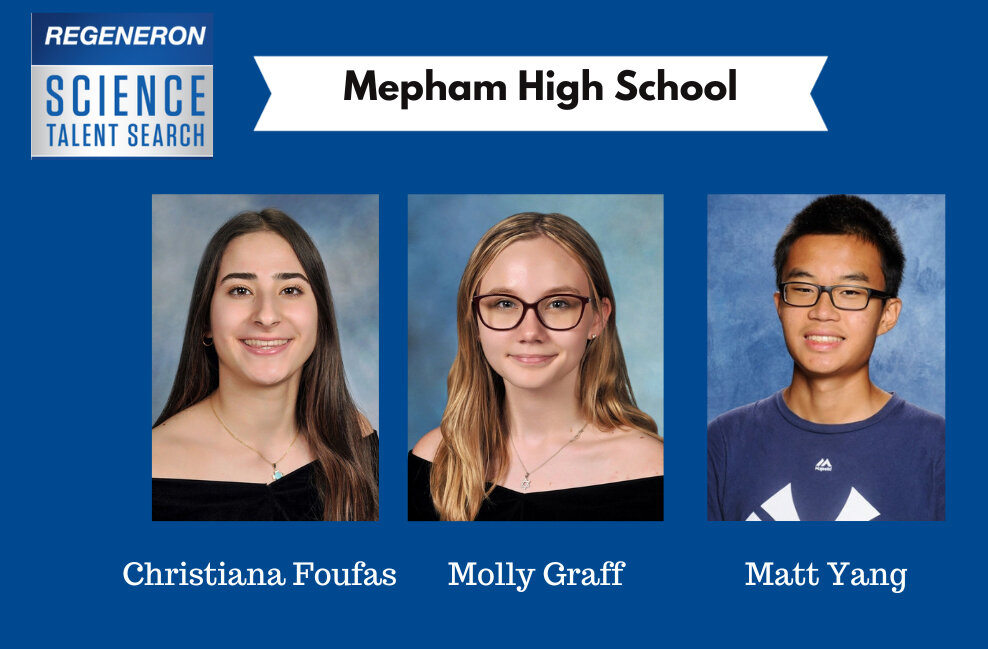Three Mepham students are named semifinalists in research competition
Students learn crucial research skills in ASR
Wellington C. Mepham High School seniors Christiana Foufas, Molly Graff and Matt Yang and were recently named semifinalists in the 2024 Society for Science & Public Science Talent Search competition, sponsored by Regeneron Pharmaceuticals. It is among the most prestigious science competitions for high school students in the United States.
Each was awarded a prize of $2,000. Mepham will also receive $2,000 per student.
“This honor exemplifies the unwavering commitment to excellence and tireless efforts both they and their teachers display on a daily basis,” Heather Bizewski, a district science chair assigned to Mepham, said.
Foufas, Graff and Yang dedicated years to science and research leading up to early November, when their projects were due. At Mepham, students in the three-year Advanced Science Research Program work under the tutelage of teachers David Kommor, Neeru Partap and Jeannette Spargifiore.
Students join the elective ASR program as sophomores, and begin their research. At the end of their junior year, they focus on entering and competing in science competitions nationwide, including Regeneron.
Graff, 17, who is originally from Wantagh, took a slightly different path on her way to becoming a Regeneron scholar. As a transfer student at Bellmore-Merrick, she didn’t join the program until last May, when Kommor agreed to take her on. While her classmates had been a part of ASR for almost two full academic years, Graff had just a few months to complete her research project.
Her project, “Think Fast: An Assessment of Cognitive Processing in Relation to Smartphone Proximity,” looked at how proximity to a smartphone impacts cognitive skills, including how fast someone thinks. Her project had two scenarios: one in which students put their phones face-down on their desks, and one in which Graff collected the devices.
Both groups of students were given math exams, and when Graff compared the results, she found the opposite of what she had predicted.
“I found that kids who (usually) have them taken away performed better during the smart phone face down condition than students who usually keep them,” she explained. “That’s where I had my statistical significance. My conclusion was that the hysteria over smartphones is kind of overblown; it’s not really as much of an issue as we perceive it to be.”
Her mentor was psychology professor Lillian Park, of SUNY Old Westbury.
“I really feel like I’ve built on a lot of research experience,” Graff said of the experience. “When I go to college and do research in college, there are a lot of skills that I have now.”
Foufas, who is Mepham’s Class of 2024 valedictorian, investigated “Adapting to Pressure: The Bone Structure-Function Relationship in the Rabbit Talus.” The North Bellmore resident, 17, studied the talus, or ankle bone, of a New Zealand rabbit, and how the pressure in two different locations impacts the structure of the bone.
Though she didn’t work directly with animals, Foufas found a study done recently at Stony Brook University on New Zealand white rabbits, and, with permission, utilized that data in her own research and analysis. That included training artificial intelligence to differentiate bone from void space in Micro-CT scans, a 3D imaging technique utilizing X-rays to see inside an object slice by slice.
Like Graff, Foufas found that the results of her study were contrary to her hypothesis. She expected the internal, spongy structure of the bone to be centered under the shinbone, due to vertical pressure, instead of closer to the toes.
“Instead, we found they’re almost equal,” she explained. “We were able to assume, for future research, that although it’s overlooked, the tensions put on bone from ligaments and tendons, we should also be looking at those instead of just focusing on forces of compression.”
Her results have implications for osteoporosis treatment and prevention.
Foufas’ mentor was Meir Barak of the bone biomechanics lab at Long Island University.
Yang, 17, Mepham’s 2024 salutatorian, studied the “MultiFormer: Single-Cell ATAC to RNA Prediction Framework.” He worked with mentor Yuying Xie, of Michigan State University.
The Bellmore resident has been interested in artificial intelligence, he said. He saw a similarity between the translation tasks of current AI models like Chat GPT, Chat Generative Pre-Trained Transformer, and Google Translate, and the biological use of predicting ribonucleic acid, which is present in all living cells, from deoxyribonucleic acid, the molecule that carries genetic information for the development and functioning of an organism.
Using statistical techniques, Yang preprocessed his finds by separating out noise and irrelevant information from what scientists can use to improve their knowledge.
“It’s statistically significant,” he said. “We’re still pretty far away from the mass use of this technology, but I’m glad I was able to contribute a little. I’m working on getting published right now.”
And Yang’s years of dedication to his research and hard work are paying off: He will attend Stanford University in the fall.
Graff and Foufas have not yet finalized their plans for this fall.
“It’s big thanks to the teachers,” Foufas said of the program. “They are truly the best. They put everything they have into this program and helped it grow over the years, and all of our success is due to them and the opportunity that we’re given. We are very grateful for them.”









